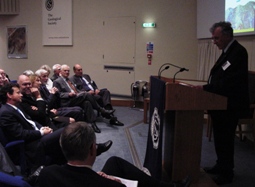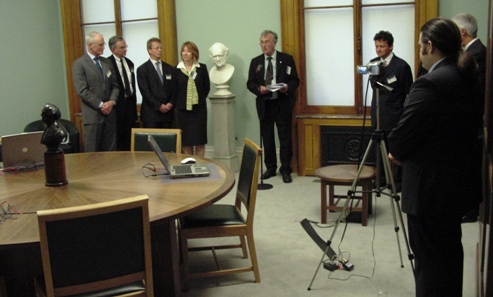
Lyell Room opening
My Lords, Ladies and Gentlemen:
We stand here before something tangible: a room - a very beautiful room - which we have created from the former Library reception and office. Something like this is easy to recognise, because you can cut a ribbon and open the door, and there it is.
However, this room is really just the visible tip of a very large iceberg.
The Lyell Room, as it shall be known, is a working environment in which readers will be able to access our new virtual library, which we are calling the Lyell Centre; though those readers will not be alone in this, because the Centre is a learning resource available to everyone, anywhere in the world, from their own terminals, via the World Wide Web.
The Lyell Centre is an integral part of the Society's new website, which we are also launching tonight. Visitors to our site will now be able to access all the Society's major published work, books and journals, right back to our foundation: a collection featuring the full content of all our wholly owned journals, Special Publications and key book series. The system also allows much more penetrating searches of our library holdings – whose index is now completely online – even to the extent of having a geographic information system – an interface that allows readers to search the catalogue maps by geographical
co-ordinates.
Creating this powerful new resource has been made possible by the generosity of our Foundation sponsors BP and Shell – and, later in the year, the Lyell Collection will be made available free of charge to the Earth science community in less developed countries thanks to the support of Schlumberger.
I must record my thanks to BP, Shell and Schlumberger for their wonderful support during this process.
A massive undertaking like this does not take place overnight, and I must now pay tribute to all those who have helped to make it a reality over the past 18 months.
Needless to say, a huge amount of work has been done by our Executive Secretary, Edmund Nickless, and Director of Publishing, Neal Marriott, - assisted by the Senior Production Editor, Sarah Gibbs. Without their drive and enthusiasm, nothing would have been possible. Elsewhere among the Society's staff, the greatest burden has fallen upon our Data Manager, Nic Bilham, who, together with Kholilur Rahman, have project-managed the immensely complex task of building the new website.

The site itself was built by SOUK, the same company (under the name Broadband Communications) who built our previous site. I should also mention the journal hosting service provided by Stanford University's HighWire Press; the digitization of over a quarter of a million pages of published work by two companies SPI and DCL; ESRI for their input to the GIS-interface; and Peter Wigley, one of our Fellows, who deserves a special tribute of thanks.
Within the Library, two members of staff under the direction of the Chief Librarian Sheila Meredith and her assistant Wendy Cawthorne, have worked solidly to complete the digital catalogue – Nicola Best and Michael Willsher. Martina Dobrikova with the Map Librarian, Paul Johnson, have been responsible for inputting the map sheet catalogue data.
Now as we prepare to inaugurate the Lyell Room, the physical manifestation of this huge invisible body of work, I should mention the conservation architects Julian Harrap Partnership and in particular Bob Sandford; our building contractors Poultney Gallagher; and furniture designers Luke Hughes, who together have created what I think you will agree is a truly wonderful room fully worthy of its setting within Burlington House.
In a moment I shall hand over to Tony Hayward [CEO, BP] and Malcolm Brinded [Executive Director, Shell Exploration & Production], representing our two Foundation Sponsors. However, I should point out now that as soon as the Lyell Room is opened, you will be able to use it, and I would encourage you to do so. Members of staff from the Society are on hand to demonstrate how the new website and its Lyell Centre actually work. Please ask them questions and see for yourself.
When we began planning this bicentenary several years ago, we said that above all we wanted it to leave a lasting legacy. The Lyell Room, Lyell Collection and Lyell Centre embody that idea in the highest degree, and I am very proud to think that they have come about "on my watch".
Thank you.